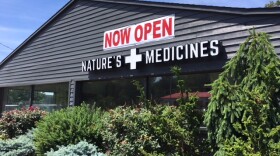As medical marijuana dispensaries continue to open up across Pennsylvania, many first-time patients still don’t know what to expect from the process, and are anxious as they go through it.
“I was a little nervous because I just don’t know how it’ll work,” said Stephanie Darpino after purchasing medical marijuana for the first time at Nature’s Medicines in State College. “But everyone was so nice and it wasn’t … I don’t know like it’s a 'drug' kind of thing. Which I wasn’t sure if that’s how it would feel, but it didn’t feel like that at all.”
She says she hopes medical marijuana will help her get off the medications she’s been taking for years.
Nervousness on a first visit to a dispensary is common, says Ben Lago, owner of Medical Marijuana Solutions, a company that certifies patients for their medical cards.
“When you go to a chiropractor or if you go to a primary care doc[tor], most folks kind of know what to expect in terms of how it’s going to work,” he said. “When folks step into a medical marijuana clinic or a dispensary, nobody knows what to expect because its so new and people just don’t have any experience.”
The first step a patient has to take to get their medical marijuana card is to go to the state’s website and register. Then they’ll see a doctor who has been approved to certify patients for their cards, like Dr. Fidelis Ejianreh of Toftrees Family Medicine.
“I will do a history and physical examination, and usually I will request old records from other treating physicians to sort of verify the information that the patient is presenting to me,” he said of his typical consultation with a prospective medical marijuana patient.
Once certified, patients pay for their cards back on the state website. It usually takes less than a week to arrive in the mail, and they’re ready to go to a dispensary.
A patient at Nature’s Medicines has to check in with a receptionist through a window when they first walk in. After that, patients are buzzed through a second door to the dispensary’s modern waiting room. It’s filled with dark leather chairs that have slick metal armrests. Large windows let in plenty of natural light. The Food Network plays on a prominently displayed flat-screen TV and patients can pick up a coffee or a snack from a little bar in the back. Many chat with their fellow patients, comparing experiences with different medical marijuana strains and delivery methods.
First-time patients at a dispensary are required to speak with a pharmacist like Nature’s Medicine’s Kirk Scudder, who says his primary job is to teach patients what this new therapy can do for them.
“I educate them regarding marijuana,” he said in his office, which is furnished much like the waiting room. “The background, history, the science, the pharmacology, the therapeutic outcomes of what we can expect. Then I help them select a product.”
Medical marijuana isn’t one-size-fits-all. There are many different strains all with different effects, and delivery methods range from vaporizers to tinctures to creams. Choosing between those options is where pharmacists like Scudder come in.
Patient Brian Gramling tailored his medical marijuana regimen to find relief from his symptoms without interrupting his daily life.
“You can customize it so you can feel the medical benefits without the euphoric effect, or having a cloudy head,” he said. “You know, I have small kids I have to do stuff with so I have to be aware, and be cognizant of your mental facilities.”
Gramling was an in-home physical therapist when he took a bad fall leaving a patient’s house on an icy day. He was taking opioids for years before he discovered Marinol, an FDA approved synthetic THC. When medical marijuana then became available, he decided to jump on the bandwagon.
“The pain is much better controlled with the medical marijuana than it ever was on the opiates. I had gone about five years without sleeping more than two hours at night, and the first night I used the Marinol I slept through the night,” he said.
Ron Boyles used his experience as a medical marijuana patient to found the Green Bridge Society, a nonprofit that helps walk patients through the entire medical marijuana process. Much of his work focuses on helping patients, especially older ones, get past the stigma around marijuana to see how it can help them.
“A lot of the people that I work with are elderly, and just have no exposure to marijuana at all other than maybe what they’ve heard,” he said in his home at Lazy Moon Ranch in Tyrone, where he holds monthly meetings for Green Bridge. “That’s a lot of where I come in, is I’m trying to help these people along.”
Regardless of age, Angel Rodriguez, manager at Nature’s Medicines, says patients’ results speak for themselves.
“We have what we would call the old school mentality, which is what we were all brought up with. You know, drugs are bad, marijuana is considered a drug, and it’s bad,” he said. “For those people that have been affected and its helped, that’s changed their mind.”
Just this year Dr. Ejianreh says he’s removed seven patients from opioids just using marijuana, and he’s seen encouraging results in patients with conditions from Parkinson’s to fibromyalgia.









